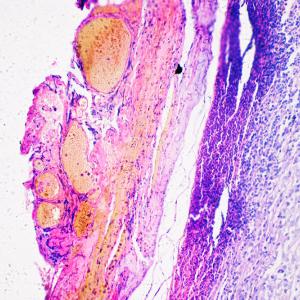New Study Shows Blood Test Does Better Job Than Current Standard Test at Tracking Severity & Potential Spread of Metastatic Melanoma
Physicians treating patients with metastatic melanoma—one of the most aggressive forms of skin cancer—may soon have a superior tool in their efforts to closely track the disease.
A new study shows that a blood test which monitors blood levels of DNA fragments from dead cancer cells does a better job than the current standard test at tracking the severity and potential spread of metastatic melanoma. The study, by researchers at NYU Langone’s Laura and Isaac Perlmutter Cancer Center, is set for publication on January 17 in the January edition of Molecular Oncology.
The standard test, in widespread use for decades to inform treatment decisions, measures blood levels of the enzyme lactate dehydrogenase, or LDH. Levels of the enzyme tend to spike during aggressive tumor growth, but are also known to rise as part of other diseases and biological functions. The alternative test looks at levels of circulating tumor DNA, or ctDNA, released into the blood when tumor cells die and break apart to spill their contents.
In the new report, the NYU Langone team found that ctDNA levels in blood were elevated in 12 of 15 patients, or 80 percent, who were about to undergo treatment for their metastatic melanoma. By contrast, blood levels of LDH were elevated before therapy in seven of 23 patients, or 30 percent. Results also showed that ctDNA could detect cancer recurrence, as confirmed by X-ray or CT scan, in 22 of 26 patients tested, or 85 percent, and undergoing therapy, while LDH was elevated in only 14 patients, or 54 percent.
“Our study results show that circulating tumor DNA is a superior blood test for evaluating and tracking progression of metastatic melanoma,” says senior study investigator and dermatologist David Polsky, MD, PhD. Polsky says recent studies have suggested that ctDNA blood testing may be useful in monitoring progression of breast and colon cancers as well. An accurate blood test is preferred by doctors and many patients because it avoids the risk of infection and pain that accompany invasive needle biopsy and the radiation exposure that comes with X-ray or CT scans.
Thirty-one patients with inoperable metastatic melanoma were involved in the newly published study, which took three years to complete. All had one of the two most common genetic mutations linked to the frequently fatal skin cancer, BRAF or NRAS. All had ctDNA and LDH blood tests performed after therapy, and most before treatment at NYU Langone. Normal blood levels of ctDNA were statistically determined by averaging results from 30 people who did not have melanoma.
Polsky says the growing number of immunological and targeted therapies for metastatic melanoma highlight the urgent need among cancer specialists for a simple but more accurate blood test to monitor the disease. Such a test would help to determine as early as possible when switching to an alternative therapy is warranted. Metastatic melanoma may be treated in different ways, including immunotherapy, targeted molecular therapies, surgery, and sometimes radiation. Fewer than 10 percent of people whose melanoma tumors have spread or metastasized survive longer than a decade after the spread is detected. More than 8,000 Americans die each year from the disease.
“A reliable blood test for tracking potential disease progression is preferred because blood tests offer feedback on what is happening throughout the body, while scans may not always visualize all parts of the body,” says Polsky, the Alfred W. Kopf, MD, Professor of Dermatologic Oncology at NYU Langone and director of its pigmented lesion section in the Ronald O. Perelman Department of Dermatology.
Among the study’s other key findings, Polsky says, was that the ctDNA test was helpful in patients with small tumors whose melanoma had nevertheless spread. Specifically, ctDNA blood levels were elevated in five of seven such cases, or 71 percent, while LDH levels were elevated in only one of 13, or 8 percent.
The research was funded by grants from the Food and Drug Administration’s Critical Path Initiative (U01 FD004203); the National Cancer Institute (R21 CA154786 and P30 CA16087), a member of the National Institutes of Health; and by the Marc Jacobs Campaign to Support Melanoma Research.
Besides Polsky, other NYU Langone researchers involved in the study were lead study investigator Gregory Chang, MBA; Jyothirmayee Tadepalli, MS; Yongzhao Shao, PhD; Yilong Zhang, MS; Sara Weiss, MD; Eric Robinson, BA; Anna Pavlick, DO; and Iman Osman, MD. Additional research support was provided by Cindy Spittle, PhD, at Molecular MD Corp. in Portland, Ore.; and Manohar Furtado, PhD; Dawne Shelton, PhD; and George Karlin-Neumann, PhD, at Bio-Rad Laboratories in Pleasanton, Calif., manufacturers of the chemicals used in ctDNA testing.
Media Inquiries
David March
Phone: 212-404-3528
david.march@nyumc.org

